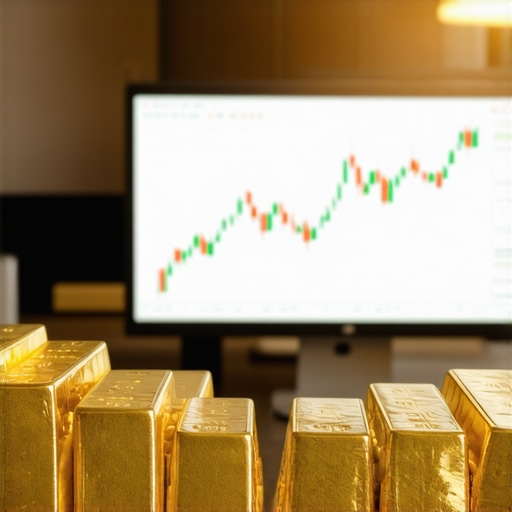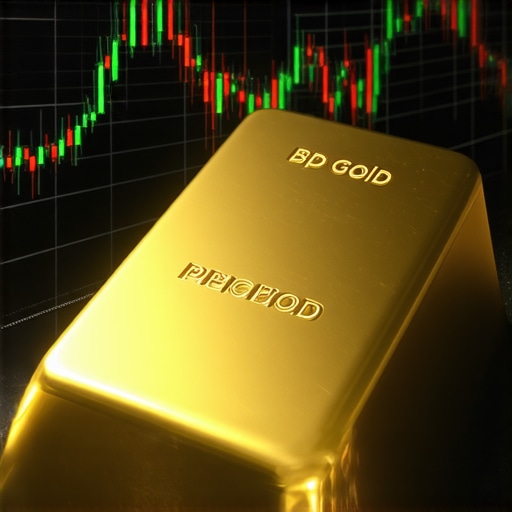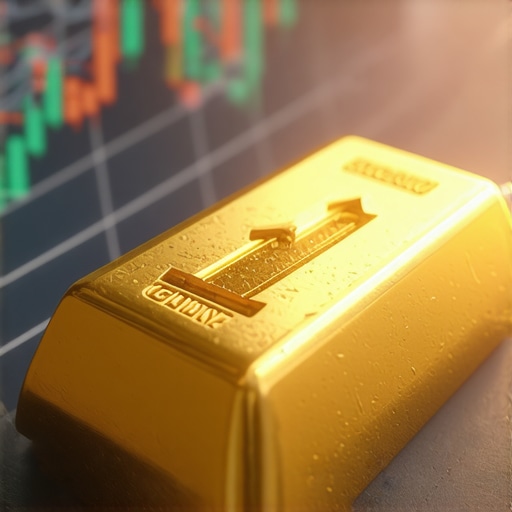Introduction: Navigating the Golden Horizon of 2026
As investors and market watchers look ahead to 2026, the gold market remains a focal point of intrigue and opportunity. Gold’s enduring status as a safe haven asset is shaped by a complex interplay of economic, geopolitical, and technological factors that will influence its price trajectory. Understanding these forces with expert clarity can empower investors to make informed decisions, hedge risks, and capitalize on profitable trends.
The Subtle Dance of Macroeconomic Indicators and Inflation Pressures
One of the central pillars affecting gold prices in 2026 will be macroeconomic conditions, especially inflation dynamics. Historically, gold has been a reliable hedge against inflationary pressures, as rising consumer prices often erode the value of fiat currencies, pushing investors toward tangible assets. Experts anticipate that persistent inflation concerns, coupled with fluctuating interest rates set by central banks, will create volatility but also underpin gold’s appeal.
Notably, the Federal Reserve’s monetary policy decisions will play a pivotal role. Should interest rates remain relatively low or decline, the opportunity cost of holding non-yielding gold diminishes, potentially fueling demand and price increases. Conversely, a tightening monetary policy could temper gold’s ascent.
Geopolitical Tensions: The Invisible Catalyst
Geopolitical unrest often acts as an invisible catalyst, driving gold prices upward as investors seek safety amidst uncertainty. In 2026, escalating global tensions, trade disputes, or regional conflicts could amplify risk aversion, boosting gold’s status as a crisis asset.
For instance, past episodes such as the 2008 financial crisis and the geopolitical uncertainties in Eastern Europe have demonstrated how gold prices spike amid turmoil. Investors should closely monitor international developments, as sudden shifts could prompt swift market reactions.
Technological Innovations Reshaping Gold Demand
Beyond traditional drivers, technological advancements are increasingly influencing gold’s market dynamics. The growing use of gold in electronics, renewable energy technologies, and medical devices is shaping demand patterns. In 2026, innovations in green technology might lead to heightened industrial gold consumption, supporting prices from the demand side.
This industrial demand complements investment demand, creating a multifaceted market landscape. Understanding these emerging trends offers investors an edge in anticipating price moves.
What Are the Most Impactful Factors Investors Should Monitor for Gold Price Movements in 2026?
Investors keen on anticipating gold price shifts should focus on several critical indicators: inflation rates, central bank policies, geopolitical developments, and technological demand trends. Additionally, monitoring gold supply factors such as mining output disruptions or central bank gold purchases can provide early signals of market tightening or easing.
Comprehensive analysis combining these elements offers a strategic perspective. For deeper insights into demand trends and market drivers, exploring resources like Analyzing Gold Demand Trends: What Investors Should Watch is highly recommended.
Harnessing Gold’s Strategic Potential: Practical Wisdom for Investors
With the complexities of the 2026 gold market clear, investors are advised to diversify their approaches. This might include a blend of physical gold holdings, exchange-traded funds (ETFs), and carefully selected gold mining stocks. Each vehicle offers distinct exposure and risk profiles.
For those looking to explore investment vehicles in depth, guides such as Top Gold ETFs and Mutual Funds for Consistent Growth provide valuable direction.
Join the conversation: What are your thoughts on gold’s future in 2026? Share your insights and investment strategies in the comments below to build a community of informed investors navigating this golden landscape together.
Source: World Gold Council – Gold Demand Trends
Personal Reflections on Navigating Gold’s Volatility
Reflecting on my own journey with gold investments, I’ve come to appreciate that understanding the nuances of market forces is just as important as following headline news. For instance, during periods when central banks increase their gold reserves, I’ve noticed a subtle but steady price uplift, which isn’t always immediately obvious to casual observers. This insight came from closely following reports by trusted organizations like the World Gold Council, whose data helped me time my purchases more strategically.
Another lesson from my experience is the importance of patience. Gold is not typically a get-rich-quick asset; it rewards those who stay the course amidst economic uncertainties. In fact, combining physical gold with gold ETFs and mining stocks has allowed me to balance liquidity with tangible security, especially during volatile times.
Practical Tips: How I Approach Gold Investments in 2026
Given the current market outlook, my approach includes regular portfolio reviews focusing on inflation trends and geopolitical risks. I also keep a close eye on technological demand shifts, which, as mentioned earlier, can subtly influence gold prices. For those starting out, I recommend exploring resources like Smart Gold Investment Strategies for Building Long-Term Wealth to build a solid foundation.
Additionally, diversifying across different forms of gold investment is key. Physical gold bars offer security and tangible value, while gold ETFs provide easier market access and liquidity. Gold mining stocks add a growth element but come with higher risk and require careful stock selection.
How Can We Better Anticipate Gold’s Price Trends Amid So Many Variables?
This question often crosses my mind, especially when markets seem unpredictable. In my view, it’s about integrating multiple data points—macroeconomic indicators, geopolitical news, and emerging tech trends—while also considering supply disruptions and central bank activities. Tools and insights from trusted financial analysts and institutions help me form a balanced perspective. What methods or tools do you find most helpful in predicting gold market movements?
If you’re curious to deepen your understanding, guides like Gold Price Forecast 2026: Expert Insights for Smart Investors offer detailed analysis and forecasting that can complement your own research.
Let’s keep this conversation going: Have you noticed particular market signals that influenced your gold investment decisions recently? Share your experiences in the comments below—your insights could be invaluable to fellow investors navigating the complexities of 2026.
Decoding Central Bank Gold Reserves: A Hidden Driver Behind Price Dynamics
Central banks continue to shape the gold market in subtle yet powerful ways. Their strategic accumulation or liquidation of gold reserves can signal confidence or caution in the global financial system. Notably, in 2026, shifts in reserve policies—often reflective of geopolitical realignments or currency diversification strategies—may provoke notable price fluctuations.
Unlike the overt impact of inflation or interest rates, these central bank moves tend to unfold gradually but with lasting consequences. For instance, recent trends highlight emerging economies increasing gold reserves as a safeguard against USD dominance, which can tighten supply and bolster prices over time. Investors who integrate central bank activity analysis into their decision matrix often gain an informational edge, anticipating market sentiment shifts before they manifest broadly.
How Do Central Bank Gold Reserve Changes Influence Market Liquidity and Price Stability?
Central bank gold reserve changes influence market liquidity by either withdrawing bullion from circulation or injecting it back, directly affecting availability. Reduced sales or increased purchases limit market supply, pushing prices upward, whereas large-scale selling can depress prices temporarily but might also indicate broader economic risks. Furthermore, reserve changes are often intertwined with currency policy adjustments, adding layers of complexity to price forecasting.
According to the World Gold Council’s Central Bank Reserves Data, nuanced patterns emerge showing that coordinated reserve increases often coincide with periods of heightened economic uncertainty, underscoring gold’s role as a stabilizing asset. Understanding these subtle market signals empowers investors to calibrate their exposure with greater precision.
Integrating Macro-Volatility Models: Predicting Gold’s Response to Complex Global Shocks
Traditional models of gold price prediction often fail to capture the multifaceted nature of 2026’s market landscape, characterized by overlapping economic, political, and technological shocks. Advanced macro-volatility models that incorporate regime switching, stochastic volatility, and geopolitical risk indices offer a more robust framework.
These models simulate scenarios where, for example, escalating trade tensions coincide with inflationary spikes and technological supply chain disruptions, collectively influencing gold demand. By leveraging such sophisticated analytical tools, investors and fund managers can better anticipate market turning points and optimize portfolio risk management.
Moreover, integrating machine learning algorithms with real-time data streams—ranging from satellite mining activity to social media sentiment—enhances predictive accuracy, creating a dynamic feedback loop between analysis and market movements.
Gold’s Role in ESG and Sustainable Investing: Emerging Trends Impacting Demand
The rising prominence of Environmental, Social, and Governance (ESG) factors is reshaping investor preferences, with gold mining companies under increasing scrutiny for sustainability practices. In 2026, ESG-compliant gold production methods may command premium valuations, influencing both supply and investor sentiment.
Innovations such as traceable supply chains, reduced environmental footprints, and community engagement are becoming essential criteria for institutional investors. This evolution not only supports ethical investing but also potentially stabilizes supply by fostering long-term operational viability.
For investors, understanding ESG certifications and the evolving regulatory landscape is crucial for identifying gold assets aligned with sustainable growth, thereby enhancing portfolio resilience amid shifting market values.
Curious about the intersection of gold and sustainability? Engage with our expert analysis and discover how ESG factors are transforming gold investment strategies for 2026 and beyond.
Harnessing ESG Momentum: Gold’s Sustainable Transformation
The integration of Environmental, Social, and Governance (ESG) principles into gold mining and investment is not merely a trend but a profound shift redefining value paradigms in 2026. Institutional investors increasingly favor gold assets with verifiable sustainable credentials, compelling mining companies to adopt rigorous environmental safeguards, ethical labor practices, and transparent governance frameworks. This evolution enhances long-term supply stability and elevates market valuations for ESG-compliant gold, thereby creating differentiated investment opportunities beyond traditional price fundamentals.
Understanding the nuances of ESG compliance requires investors to scrutinize certification standards like the Responsible Jewellery Council (RJC) and the London Bullion Market Association’s (LBMA) Responsible Gold Guidance. Such frameworks ensure traceability and accountability, mitigating reputational and regulatory risks that could otherwise destabilize supply chains. Consequently, ESG factors are emerging as a critical lens for anticipating shifts in gold demand and pricing dynamics.
Macro-Volatility Models: Navigating Complex Global Shocks with Precision
Traditional gold price forecasting models often fall short in encapsulating the intricate interplay of geopolitical, economic, and technological shocks characterizing 2026. Advanced macro-volatility models employing regime-switching algorithms, stochastic volatility frameworks, and geopolitical risk indices provide a sophisticated analytical apparatus capable of capturing nonlinear market responses.
For instance, these models can simulate scenarios in which inflationary pressures coincide with escalating trade conflicts and supply chain disruptions, enabling investors to evaluate potential gold demand surges or contractions under varying stress regimes. The fusion of machine learning techniques with live data inputs, such as satellite imagery of mining operations and sentiment analysis from global news flows, further refines predictive accuracy, empowering portfolio managers to optimize hedging strategies and risk-adjusted returns.
In What Ways Can Advanced Analytics and ESG Considerations Synergize to Enhance Gold Investment Strategies?
Integrating ESG metrics with macro-volatility predictive models offers a multidimensional investment approach that aligns sustainability with financial performance. By incorporating ESG scores and compliance data into volatility forecasts, investors can identify gold assets that not only exhibit resilience amid economic shocks but also adhere to evolving regulatory and ethical standards. This synergy supports the construction of portfolios that mitigate downside risks linked to environmental controversies or governance lapses while capitalizing on market dislocations triggered by macroeconomic uncertainties.
For practitioners seeking to deepen their expertise, the World Gold Council’s research on Gold Demand Trends provides authoritative insights into how ESG factors and macroeconomic volatility converge to influence global gold markets.
Elevate your investment acumen: Engage with these advanced perspectives to strategically position your portfolio for the nuanced realities shaping gold’s trajectory in 2026. Share your experiences or questions below to collaborate with a community of sophisticated investors navigating this complex landscape.

Frequently Asked Questions (FAQ)
What key economic indicators most influence gold prices in 2026?
Inflation rates, central bank interest rate policies, and currency strength—especially the US dollar—are primary economic indicators shaping gold prices. Rising inflation typically boosts gold demand as a hedge, while interest rate hikes can dampen appeal due to opportunity costs. Monitoring these alongside GDP growth and unemployment provides a holistic view.
How do geopolitical events impact gold’s safe-haven status?
Geopolitical tensions, such as conflicts, trade disputes, or political instability, often trigger risk aversion among investors, increasing demand for gold as a crisis asset. Such events can cause rapid price spikes as markets seek stability amid uncertainty.
In what ways is technological innovation affecting gold demand?
Advancements in electronics, renewable energy, and medical technologies are driving industrial gold consumption higher. Emerging green technologies requiring gold components enhance demand beyond investment and jewelry sectors, supporting prices through diversified demand sources.
Why should investors pay attention to central bank gold reserves?
Central banks’ buying or selling activities influence gold supply and market sentiment. Accumulation signals confidence in gold’s value and can tighten supply, elevating prices. Conversely, large sales may depress prices temporarily but often reflect broader economic strategies.
What role do ESG factors play in gold investment strategies?
Environmental, Social, and Governance (ESG) considerations are increasingly critical. Investors prefer gold sourced from sustainable mining practices with transparent supply chains, which can command premium valuations and reduce regulatory and reputational risks, thus impacting demand and pricing.
How can advanced macro-volatility models improve gold price forecasting?
These models incorporate complex variables—economic cycles, geopolitical risks, and supply disruptions—using regime-switching and stochastic volatility methods. They allow investors to simulate diverse scenarios, improving predictive accuracy and risk management in volatile markets.
What investment vehicles are optimal for exposure to gold in 2026?
A diversified approach is recommended: physical gold for tangible security, gold ETFs for liquidity and market accessibility, and selected mining stocks for growth potential. Each has distinct risk-return profiles suited to different investor goals.
How do machine learning and real-time data impact gold market analysis?
Machine learning algorithms process vast data streams—like satellite imagery of mining activity and sentiment analysis—to identify patterns and early signals. This dynamic integration enhances forecasting precision and timely decision-making.
Can ESG integration and volatility models be combined for better investment decisions?
Yes, merging ESG scores with volatility forecasts creates multidimensional strategies that align sustainability with financial resilience, enabling investors to mitigate risks associated with environmental or governance issues while capitalizing on market fluctuations.
What should beginner investors understand before entering the gold market?
Beginners should grasp gold’s role as a long-term hedge against inflation and uncertainty, the diversity of investment options, and the importance of monitoring macroeconomic and geopolitical developments. Starting with educational resources and a balanced portfolio approach is essential.
Trusted External Sources
- World Gold Council (WGC): The premier authority on gold market research, offering comprehensive data on demand trends, central bank reserves, and ESG initiatives, vital for informed investment decisions.
- International Monetary Fund (IMF): Provides macroeconomic analyses and reports on global financial stability, including central bank gold reserve activities impacting market liquidity.
- Bloomberg Professional Services: Delivers real-time market data, geopolitical risk indices, and advanced analytics critical for tracking gold price drivers and implementing volatility models.
- London Bullion Market Association (LBMA): Sets standards for responsible sourcing and provides detailed insights into gold market operations and ESG compliance frameworks.
- Journal of Commodity Markets: Offers peer-reviewed academic research on commodity price modeling, including advanced macro-volatility forecasting and machine learning applications relevant to gold.
Conclusion: Navigating Gold’s Complex Landscape in 2026
The gold market in 2026 presents a multifaceted arena where macroeconomic forces, geopolitical uncertainties, technological innovation, and ESG considerations converge to shape price trajectories. Expert analysis reveals that inflation trends, central bank reserve policies, and emerging industrial demand are pivotal drivers. Advanced forecasting models incorporating volatility and sustainability metrics empower investors to anticipate and navigate market complexities with greater precision.
Strategic diversification across physical holdings, ETFs, and mining equities, coupled with a vigilant eye on global developments, enhances resilience and opportunity capture. Embracing these insights positions investors to harness gold’s enduring value amid evolving financial landscapes.
We invite you to share your perspectives, questions, or strategies in the comments below and explore our related expert content to deepen your understanding and optimize your gold investment journey in 2026 and beyond.











This comprehensive analysis really highlights how multifaceted the gold market is heading into 2026. In my experience, one area often overlooked is the impact of technological demand, especially in green energy sectors. As renewable technologies become more prevalent, the industrial demand for gold might see a significant uptick, which could help stabilize prices even during periods of volatility. I’ve been curious, though—how do investors typically balance between industrial demand and the more traditional investment drivers like inflation hedging? Do you think focusing on ESG-compliant gold assets can serve as a buffer during unpredictable geopolitical shifts? It seems that integrating macro-volatility models with ESG insights could really provide a more resilient investment framework, especially given the rising importance of sustainable sourcing. Would love to hear others’ thoughts on how they see these factors playing out together in the next few years.